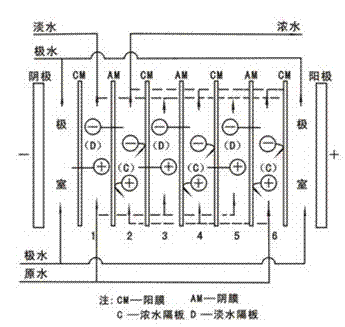Method for extracting and separating L-leucine by using combined technology of membrane separation and electrodialysis
A technology of leucine and fermentation broth, applied in the field of extraction and separation of L-leucine, can solve the problems of affecting product quality and yield, incomplete removal of bacterial cells, broken resin structure, etc., and achieves ionic impurities and The effect of reducing the pigment content, reducing the decolorization process of activated carbon, and improving the light transmittance of the material liquid
- Summary
- Abstract
- Description
- Claims
- Application Information
AI Technical Summary
Problems solved by technology
Method used
Image
Examples
Embodiment 1
[0028] 5.0L of L-leucine fermentation broth was filtered through an ultrafiltration membrane with a molecular weight cut-off of 200,000 to remove bacteria. The operating pressure was 0.3MPa, the temperature was 30°C, and the volume of dialysis water was 1.5 L. Then through a 6L combined electrodialysis membrane device at a temperature of 30°C, a desalinated L-leucine supernatant was obtained. The desalinated clear liquid is filtered through a nanofiltration membrane with a molecular weight cut-off of 500 to remove small molecular impurities and pigments. The operating pressure is 1.2MPa, the temperature is 30°C, and the dialyzed water volume is 3.6L, and then concentrated and crystallized by conventional methods to obtain the product. The results are shown in Table 1 below:
[0029] Electrodialysis electric drive membrane separator: stock solution conductivity: 22400μS / cm
[0030] Conductivity of desalted liquid: 500μS / cm
[0031] ...
Embodiment 2
[0035] 350L of L-leucine fermentation broth was filtered through an ultrafiltration membrane with a molecular weight cut-off of 800,000 to remove bacteria. The operating pressure was 0.36 MPa, the temperature was 30°C, and the volume of dialysis water was 120L. Then go through a 500L combined electrodialysis membrane device at a temperature of 30°C to obtain a desalinated L-leucine serum. The desalted clear liquid is filtered through a nanofiltration membrane with a molecular weight cut-off of 500 to remove small molecular impurities and pigments. The operating pressure is 1.2MPa, the temperature is 30°C, and the dialyzed water volume is 240L. Then, the product is concentrated and crystallized by conventional methods. The results are shown in Table 2 below:
[0036] Electrodialysis electric drive membrane separator: stock solution conductivity: 22500μS / cm
[0037] Conductivity of desalted liquid: 600μS / cm
[0038] Salt re...
Embodiment 3
[0042] L-leucine fermentation broth 4.5M 3 The bacterial cells are removed by ultrafiltration with a molecular weight cut-off of 800,000, the operating pressure is 0.4MPa, the temperature is 30°C, and the dialyzed water volume is 1.5 M 3 . The filtrate completely removes the bacteria, and then passes through 8M 3 The combined electrodialysis membrane equipment is used at a temperature of 30°C to obtain desalinated L-leucine supernatant. The desalted clear liquid is filtered through a nanofiltration membrane with a molecular weight cut-off of 1000 to remove small molecular impurities and pigments. The operating pressure is 1.2MPa, the temperature is 30°C, and the dialyzed water volume is 3.1M. 3 , and then use conventional methods to concentrate and crystallize the product. The results are shown in Table 3 below:
[0043] Electrodialysis electric drive membrane separator: stock solution conductivity: 22650μS / cm
[0044] Conductivity of desalted liquid: 600μS / cm
[0045] S...
PUM
| Property | Measurement | Unit |
|---|---|---|
| salt rejection rate | aaaaa | aaaaa |
| salt rejection rate | aaaaa | aaaaa |
Abstract
Description
Claims
Application Information
 Login to View More
Login to View More - R&D
- Intellectual Property
- Life Sciences
- Materials
- Tech Scout
- Unparalleled Data Quality
- Higher Quality Content
- 60% Fewer Hallucinations
Browse by: Latest US Patents, China's latest patents, Technical Efficacy Thesaurus, Application Domain, Technology Topic, Popular Technical Reports.
© 2025 PatSnap. All rights reserved.Legal|Privacy policy|Modern Slavery Act Transparency Statement|Sitemap|About US| Contact US: help@patsnap.com

